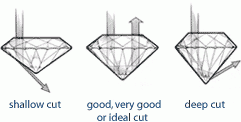 For most people, buying a diamond is a new experience, but that doesn’t mean it should be overwhelming. Understanding a diamond’s quality characteristics is straightforward and simple.
For most people, buying a diamond is a new experience, but that doesn’t mean it should be overwhelming. Understanding a diamond’s quality characteristics is straightforward and simple.
The first step is to ensure your diamond is certified. A diamond certificate is proof that a diamond has been analyzed by an unbiased team of gemologists. Diamond Search is an interactive tool that allows you to choose from thousands of diamonds certified by the two most respected independent diamond labs, the GIA or AGSL. All certified diamonds are graded based on the four Cs: cut, colour, clarity, and carat weight.
 Cut: The diamond’s cut determines its fire and brilliance. Cut grade is established by defining the relationship between a diamond’s light performance, dimensions, and finish. Even with exceptional colour and clarity, if a diamond is poorly cut, it will look dull. Choose a good, very good, or ideal cut grade.
Cut: The diamond’s cut determines its fire and brilliance. Cut grade is established by defining the relationship between a diamond’s light performance, dimensions, and finish. Even with exceptional colour and clarity, if a diamond is poorly cut, it will look dull. Choose a good, very good, or ideal cut grade.
Colour: Diamonds are graded based on the presence or absence of colour. Diamonds with less colour have a better grade and will display more colourful fire. A diamond with a colour grade of D, E, or F is regarded as colourless. Colour grades of G, H, I, and J are considered near-colourless, and can offer excellent values.

Clarity: Trained gemologists use strict guidelines to summarise and map the flaws, or inclusions, in a diamond. While diamonds with flawless clarity are rare and expensive, a diamond with no flaws visible to the unaided eye, referred to as eye-clean, can offer outstanding value without sacrificing brilliance. Choose VS1 or VS2 grades or better.
Carat Weight: Carat is a measure of weight, not size, and two diamonds with the same carat weight but different cut characteristics will not appear to be the same size when viewed from the top. Also, in general, it takes about a 20% increase in carat weight before most people will notice a difference in size.
This infomation was adapted from the educational resources found on the Blue Nile website.
